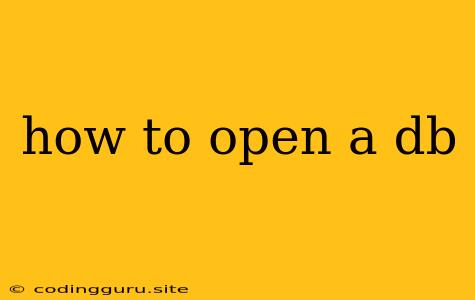How to Open a Database: A Comprehensive Guide
Opening a database is the first step in interacting with your data. Whether you're a seasoned developer or just starting out, understanding the process is crucial for managing and accessing your information. This guide will walk you through the steps involved in opening a database, covering different scenarios and providing clear instructions.
What is a Database and Why Open It?
A database is a structured collection of data that can be easily accessed, managed, and updated. Think of it as an organized filing system for all your information. You might use a database to store customer details, product inventory, financial records, or any other data that needs to be systematically managed.
Opening a database allows you to:
- Access the data: You can retrieve specific information from the database based on your needs.
- Modify the data: You can update, insert, or delete data within the database.
- Perform queries: You can search for and retrieve data using specific criteria.
- Run scripts: You can automate tasks and manipulate the data using programming scripts.
Understanding Database Types
Different database types exist, each with its own characteristics and methods of access. Here are some common database types:
- Relational databases (RDBMS): These databases organize data into tables with rows and columns, facilitating relationships between different data sets. Examples include MySQL, PostgreSQL, and Oracle.
- NoSQL databases: These databases offer more flexible data structures than RDBMS, making them suitable for handling large volumes of unstructured data. Examples include MongoDB, Cassandra, and Redis.
How to Open a Database: A Step-by-Step Guide
The specific steps for opening a database will vary depending on the database type and the tools you're using. Here's a general overview:
1. Install the Necessary Software:
- Database Management System (DBMS): Choose a suitable DBMS for your database type. For example, for MySQL, you'll need to install the MySQL server software.
- Client software: To connect to the database and interact with it, you'll need a client application. Many DBMS come with built-in clients, or you can use third-party tools.
2. Configure Database Connection Settings:
- Host: This is the server where the database is running.
- Port: This is the specific port number used for communication with the database.
- Username: The username for accessing the database.
- Password: The password associated with the username.
- Database name: The specific database you want to access.
3. Connect to the Database:
- Using command-line tools: You can use tools like mysql (for MySQL) to connect to the database using commands.
- Using graphical interfaces: Some database clients provide graphical interfaces for connecting and managing the database.
4. Open the Database:
- For RDBMS: Once connected, you can issue commands to open specific tables within the database.
- For NoSQL databases: The process of "opening" a database may be slightly different, depending on the specific database type.
Tips for Opening a Database
- Use a secure password: Protect your database with a strong password.
- Backup your database regularly: This prevents data loss in case of system failure.
- Monitor your database: Keep an eye on performance metrics to ensure smooth operation.
Examples:
- MySQL: You can open the
employeesdatabase in MySQL using the following command:
mysql -u user -p employees
- MongoDB: To connect to a MongoDB database, you can use a tool like MongoDB Compass and specify the connection details.
Conclusion
Opening a database is a fundamental step in working with data. By following the steps outlined in this guide and considering the best practices for database management, you can ensure a secure and efficient connection to your data. Remember to choose the right tools and techniques for your specific needs and database type.
